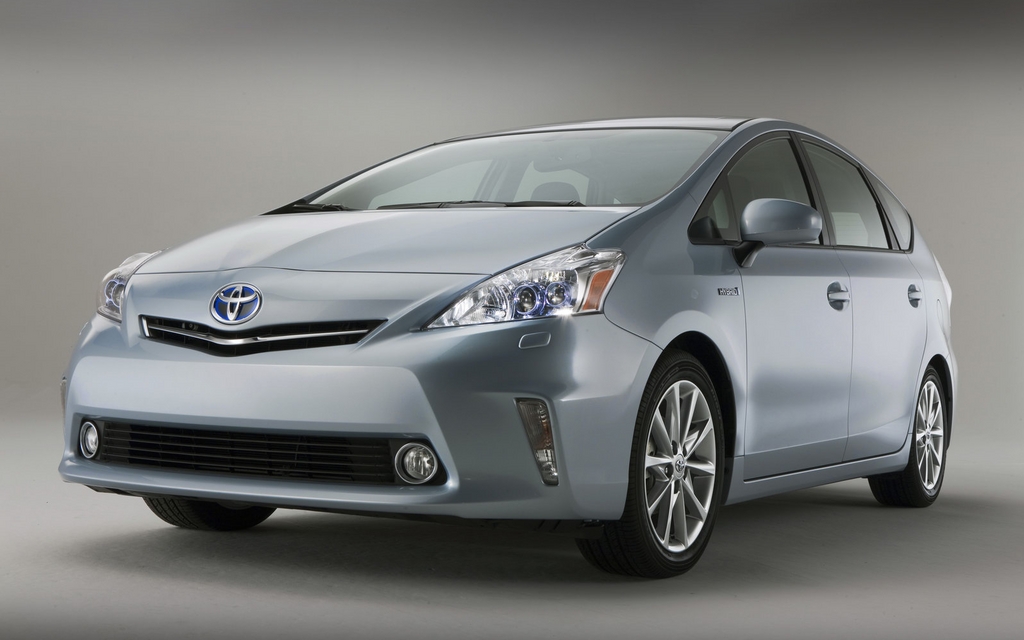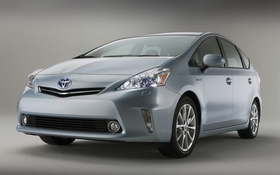2012 Toyota Prius V: A Cabbie's Dream

| Strong points |
|
|---|---|
| Weak points |
|
If the Checker Cab defines New York, and the Hackney Carriage synonymises London, then the Toyota Prius has truly become the symbol of the west coast car-for-hire industry. Be it a side-effect of our greenish-hued sense of obligation or merely an opportunity uniquely afforded by this region's less arduous inclement conditions, if you call for cab anywhere between Vancouver and San Diego, what pulls up a few minutes later will probably be a Prius. Which is precisely why Toyota's made this: the Prius V.
Now, I understand that Toyota's marketing the Prius V as the token crossover of the Prius' rapidly expanding family, but I can't wrap my brain around any other reality than the one in which the Prius V's development wasn't earmarked by a strong desire to actively pursue taxi fleet sales. It is, after all, the perfect size. Dimensionally similar to the underrated Mazda5 minivan, it's almost imperceptibly larger than the already efficiently-sized standard Prius, with the Prius V's almost identical silhouette making distinguishing it from the standard car even more difficult. Between the two cars' length, width, and height measurements, the sum difference runs just 9.8 inches in total.
And the difference between the two doesn't seem to get much more apparent from the space within, either. Although possessing an additional three inches between the wheelarches and a further two inches in total, the Prius V's cabin is oddly similar in proportion the existing model's. In fact, visiting Toyota's website confirms that both front and rear seat legroom is actually slightly diminished in the V, while rear seat headroom goes completely unchanged. However, it's not all bad news: both front seats are blessed with a two inch increase in headroom whilst shoulder room grows one inch up front and two in the rear. But the big news, if you'll pardon the pun, that is, is the cargo capacity. Up a whopping 70 percent (with everything folded, of course), the new V will swallow 34 cubic feet of cargo aft of the rear seats with the standard car maxing out at just 21.4 cubic feet.
However, the increased cargo capacity isn't the only concession it makes to its future cabbie career. First off, there's the somewhat oddly designed interior. Instead of the Prius' organically shaped center console and smoothly integrated center gauge cluster, there is a blocky, door-to-door, straight-across-the-cabin dashboard that is the absolute portrait of utilitarian auto design. Similarly, the materials used throughout the interior feel shockingly similar to those that you'd find inside Nissan's NV2500 or Ford's Transit Connect van: hard-wearing and equally hard to the touch. Likewise, the switchgear and controls are only slightly more interesting to look at than those found on a pay phone, but to their credit, feel about as robust. But, I did find the giant climate control dial to be oddly prominent, and the seat-heater switch is just weird. Once you get used to reaching for it, it's not quite as bad, but unless you plan on fumbling for it, it demands that your eyes come way far down from the road ahead.
Not that anything is going to be coming at you all that quickly in such a car as this. Powered by the same engine as the regular Prius, the V "boasts" 134 horsepower, but drives through a shorter 3.70:1 final drive as opposed to the standard Prius' 3.27:1 gearset. This obviously helps the car in an urban setting, but doesn't quite offset the bigger car's girth, and the resulting acceleration statistics are still slightly less impressive than the Prius' already milquetoast figures. Furthermore, if you're commuting from the suburbs and spend much time on the highway, the shorter final drive will negatively impact your average fuel economy. Around town, however, the shorter gearing does have the interesting side effect of multiplying the electric motor's torque output, which in turn allows pretty decent acceleration without engaging the gasoline engine.
And of course, for most cab drivers, that's exactly what they'll enjoy about the Prius V. Their employers will certainly like the large voids in the center console for communications and meter equipment installations, and customers should find the overall space and cargo capacity to be ample. But what about you or I? Well, that's a bird of a different feather, and if I'm honest, the average human being is a bird that's probably slightly better suited by the standard Prius. With better fuel economy for more mixed driving, nearly the same passenger-space dimensions, a more refined interior, and a cheaper price tag, the good old Prius seems to eke out a small lead in my mind over its new sibling, especially for buyers that might already own a larger vehicle. Then again, with the added versatility that comes with the larger trunk, and a real-world fuel cost difference that's probably best defined as marginal, there's certainly a place for this new car amongst families looking for one do-all vehicle that won't suck their wallets dry. However, if that sounds like you, please consider this one last word of advice: do yourself a favour. Don't paint it yellow.










